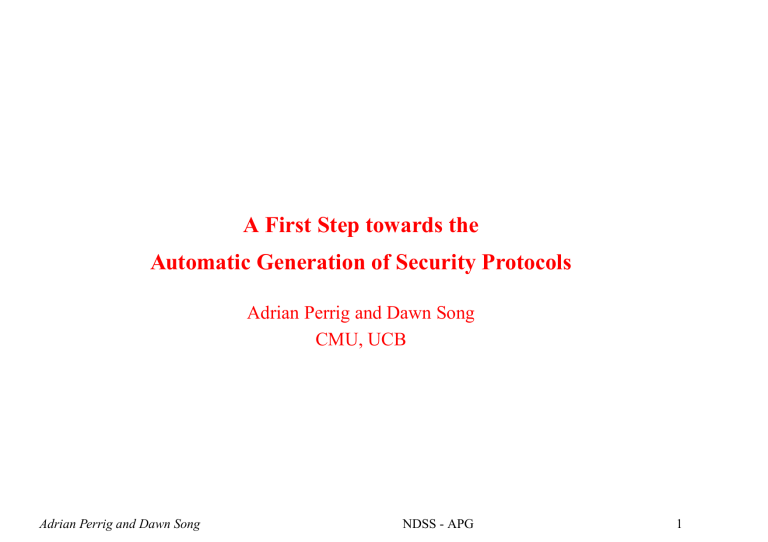
A First Step towards the Automatic Generation of Security Protocols Adrian Perrig and Dawn Song CMU, UCB Adrian Perrig and Dawn Song NDSS - APG 1 Difficulties in the Design of Security Protocols Usually ad-hoc, lacking formalism. Hidden assumptions weaken security. Error-prone. A Classic Example: Needham-Schroeder public key authentication protocol [NS78], in which Gavin Lowe discovered a flaw 18 years later! [Low96] Limited proof of security, low confidence Limited search capability of designer, results in suboptimal protocols Slow process. Fixing flaws can be expensive Adrian Perrig and Dawn Song NDSS - APG 2 Automatic Protocol Generation User enters security requirements and system specification and APG outputs the optimal secure protocol Security Properties Metric Function Automatic Protocol Generation (APG) Correct Protocols Initial Setup System Requirements APG consists of a protocol generator and a protocol verifier, for which we use Athena Protocol Generator Adrian Perrig and Dawn Song Candidate Protocols Protocol Verifier Athena NDSS - APG 3 Advantages of APG Fully automatic, no user intervention High confidence High Quality Flexible Custom-tailored security protocols for each application Adrian Perrig and Dawn Song NDSS - APG 4 Grammar to Generate Security Protocols Grammar for representing messages in authentication protocols M essage ::= Atomic j E ncrypted j C oncatenated Atomic ::= Principalname j Nonce j K ey E ncrypted ::= (M essage; Key) K ey ::= PublicKey j PrivateKeyj SymmetricKey C oncatenated ::= M essage; M essage j M essage; C oncatenated Message representation through a tree structure Concat A B Encr Concat A Adrian Perrig and Dawn Song Kb B NDSS - APG 5 Metric Function to describe System Requirements Metric reflects the utility function, which defines the cost of a protocol Assign a cost to each operation Operation Sample 1 Sample 2 Sending cost per atomic element 1 3 Nonce generation 1 1 Symmetric encryption/decryption 3 1 Asymmetric encryption/decryption 7 2 E.g. the cost of the message A; B; fA; B gKAB is 8 (Sample 1). A correct protocol with the minimal cost is the optimal protocol (with respect to the metric function). Adrian Perrig and Dawn Song NDSS - APG 6 Sacrifice Completeness to Achieve Practicality Vast protocol space – Even for two-party mutual authentication protocols might take years for a protocol verifier to explore – Our goal is to make APG interactive Limiting the depth of the messages reduces the protocol space Don’t consider permutation of message components fA; NA gKAB fNA ; AgKAB Adrian Perrig and Dawn Song NDSS - APG 7 The Athena security protocol verifier [Son99] Automatic verifier for security protocols Model checker / theorem prover hybrid Uses the Strand Space Model [THG98] Athena either proves correctness (without a bound on the number of sessions) or gives a counterexample Highly efficient, on the order of 10 prot/s (3 parties, 4 rounds) Adrian Perrig and Dawn Song NDSS - APG 8 Case Study: Automatic Generation of Two-Party Mutual Authentication Protocols Explore two-party mutual authentication protocols for different settings – Authentication using either symmetric or asymmetric keys – Principals are either bandwidth-limited or communication-limited Good starting point - large number of known protocols to compare against Adrian Perrig and Dawn Song NDSS - APG 9 Overcome the Protocol Space Explosion Problem Despite the optimisations, the protocol space is still vast Solution: Add a simple and fast protocol verifier to the generator Look for simple impersonation attacks Recognize simple replay attacks Result: Fast to check, yet highly effective Type Cost Generated I.A. R.A. Comb. Cand. Corr. Symmetric 10 19856 12098 18770 19449 407 2 Asymmetric 14 46518 46378 40687 46408 110 1 Adrian Perrig and Dawn Song NDSS - APG 10 Impersonation Attack Module Each principal has an impersonator, IA for A, IB for B Each impersonator is updated as follows – Knows all principal names – Knows all public keys – Receives all of its principal’s nonces – Eavesdrops messages and reads what it can decrypt Example protocol: Protocol : A ! B : NA ; A B ! A : NB ; fNA ; A; B gKAB A ! B : NA ; NB A can easily impersonate A I Adrian Perrig and Dawn Song NDSS - APG 11 Replay Attack Module Detects attacks where an eavesdropper can impersonate a principal by replaying messages from a previous run Example protocol: Protocol : A ! B : A; fNA ; AgKAB B ! A : fNA ; NB ; A; B gKAB A ! B : NA ; B An adversary can impersonate A by replaying messages 1 and 3 Adrian Perrig and Dawn Song NDSS - APG 12 Results: Symmetric-Key Authentication Protocols Minimal protocols (cost = 10) for sample 1 costs Optimal protocols for computation-limited systems Protocol : Protocol : Adrian Perrig and Dawn Song A ! B : NA ; A B ! A : fNA ; NB ; AgKAB A ! B : NB A ! B : NA ; A B ! A : fNA ; NB ; B gKAB A ! B : NB NDSS - APG 13 Results: Symmetric-Key Authentication Protocols II For bandwidth-limited devices, we want to minimise communication overhead Increasing the sending cost reveals the following optimal protocol Protocol : Adrian Perrig and Dawn Song A ! B : fNA ; AgKAB B ! A : fNA ; NB gKAB A ! B : NB NDSS - APG 14 Results: Asymmetric-Key Authentication Protocols In the case of asymmetric keys, the fixed version of the Needham-Schroeder protocol is optimal for communication-limited and computation-limited settings Protocol : Adrian Perrig and Dawn Song A ! B : fNA ; AgKB B ! A : fNA ; NB ; B gKA A ! B : NB NDSS - APG 15 Remaining Challenges / Future Work Current work is on three-party authentication protocols Protocol space grows exponentially in protocol complexity Automatic generation of source code Repair of flawed protocols, protocol optimisation Adrian Perrig and Dawn Song NDSS - APG 16 Conclusions Initial results look promising, APG needs further study Even though two-party mutual authentication protocols were intensely studied, APG discovered novel and efficient protocols APG generates custom-tailored optimal protocols for each application Adrian Perrig and Dawn Song NDSS - APG 17 References [Low96] G. Lowe. Breaking and fixing the Needham-Schroeder public-key protocol using FDR. In Tools and Algorithms for the Construction and Analysis of Systems, volume 1055 of Lecture Notes in Computer Science, pages 147–166. Springer-Verlag, 1996. [NS78] R. Needham and M. Schroeder. Using encryption for authentication in large networks of computers. Communications of the ACM, 21(12):993–999, 1978. [Son99] Dawn Song. Athena: An automatic checker for security protocol analysis. In Proceedings of the 12th Computer Science Foundation Workshop, 1999. [THG98] F.Javier Thayer, Jonathan C. Herzog, and Joshua D. Guttman. Strand spaces: Why is a security protocol correct? In Adrian Perrig and Dawn Song NDSS - APG 18 Proceedings of 1998 IEEE Symposium on Security and Privacy, 1998. Adrian Perrig and Dawn Song NDSS - APG 19


